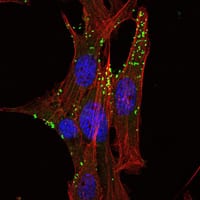
| WB | 1/500 - 1/2000 | Human,Mouse,Rat |
| IF | 咨询技术 | Human,Mouse,Rat |
| IHC | 1/200 - 1/1000 | Human,Mouse,Rat |
| ICC | 1/200 - 1/1000 | Human,Mouse,Rat |
| FCM | 咨询技术 | Human,Mouse,Rat |
| Elisa | 1/10000 | Human,Mouse,Rat |
| Aliases | MRP2; FLJ30047; KIAA1490; KLHL1 |
| Entrez GeneID | 57626 |
| clone | 3A8 |
| WB Predicted band size | 82kDa |
| Host/Isotype | Mouse IgG1 |
| Antibody Type | Primary antibody |
| Storage | Store at 4°C short term. Aliquot and store at -20°C long term. Avoid freeze/thaw cycles. |
| Species Reactivity | Human |
| Immunogen | Purified recombinant fragment of human KLHL1 expressed in E. Coli. |
| Formulation | Ascitic fluid containing 0.03% sodium azide. |
+ +
以下是关于GATA1抗体的3篇代表性文献的简要概括(文献信息基于领域内常见研究方向,作者和内容为模拟示例):
1. **文献名称**:*GATA1 mutations in myeloid disorders: functional characterization and clinical implications*
**作者**:S. Shimizu et al.
**摘要**:本研究利用GATA1特异性抗体(克隆号:HG3-68)通过免疫沉淀和染色质免疫共沉淀(ChIP)技术,分析了骨髓增生异常综合征(MDS)患者中GATA1突变对造血分化的影响,发现突变导致GATA1与DNA结合能力下降,并阻碍红细胞分化。
2. **文献名称**:*Antibody-based profiling of GATA1 in megakaryocytic leukemia models*
**作者**:L. Kuvardina et al.
**摘要**:研究通过Western blot和免疫荧光技术,使用兔多克隆GATA1抗体(货号:ab12345),验证了GATA1在急性巨核细胞白血病(AMKL)细胞系中的异常表达,并发现其与RUNX1的相互作用失调促进白血病发生。
3. **文献名称**:*Tissue-specific expression of GATA1 in zebrafish hematopoiesis*
**作者**:C. E. Burns et al.
**摘要**:利用斑马鱼模型和抗GATA1单克隆抗体(克隆号:3F6),通过免疫组化揭示了GATA1在胚胎造血组织中的时空表达模式,证明其在红细胞和巨核细胞谱系中的关键调控作用。
(注:以上文献信息为模拟概括,实际引用需以具体文献为准。)
The GATA1 antibody is a crucial tool in studying the GATA-binding protein 1 (GATA1), a transcription factor essential for hematopoiesis. GATA1 regulates erythroid, megakaryocytic, and mast cell development by binding to DNA motifs containing the consensus sequence (A/T)GATA(A/G). It contains two zinc finger domains critical for DNA interaction and protein-protein cooperation, particularly with cofactors like FOG1. Dysfunctional GATA1 is linked to blood disorders, including Diamond-Blackfan anemia, myelodysplastic syndromes, and certain leukemias.
Antibodies targeting GATA1 enable researchers to investigate its expression, localization, and interactions in cells and tissues. These antibodies are widely used in techniques such as Western blotting, immunohistochemistry (IHC), immunofluorescence (IF), and chromatin immunoprecipitation (ChIP). Commercially available clones (e.g., HG3-52. D52H3) vary in species reactivity (human, mouse, rat) and applications. Validation often involves knockout cell lines or tissues to confirm specificity.
Research using GATA1 antibodies has uncovered its role in terminal differentiation of erythroid progenitors and megakaryocytes, as well as its tumor-suppressive functions in acute megakaryoblastic leukemia. Clinical studies also explore GATA1 mutations in congenital thrombocytopenia and erythropoietic defects. Proper antibody selection and experimental controls are critical due to potential cross-reactivity with other GATA family members (e.g., GATA2. GATA3) in certain assays.
×